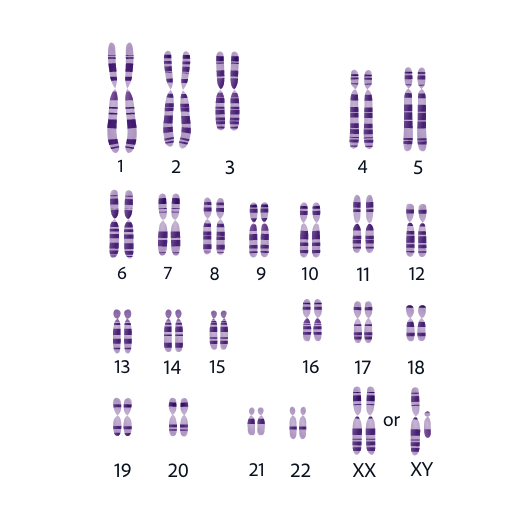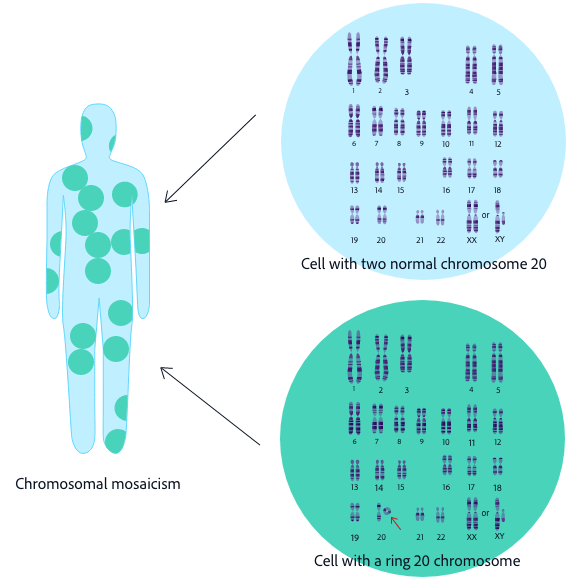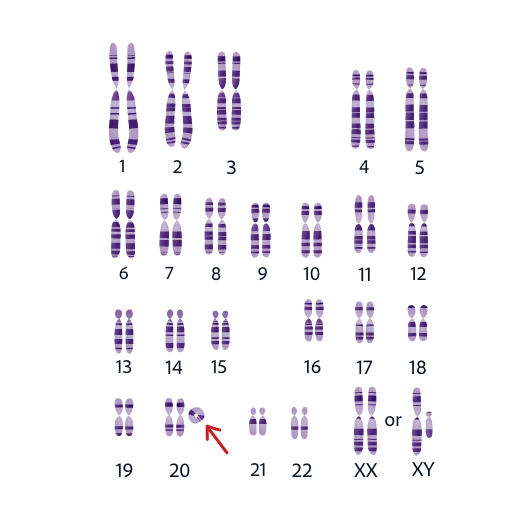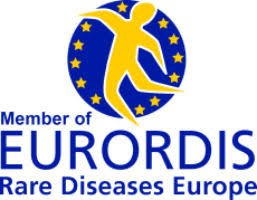Understanding your Karyotype test results
Ring Chromosomes are typically diagnosed using a testing technique called karyotyping which is used to look at the Chromosomes in the cells in your body.
If something unusual is detected in your cells, such as a ring chromosome, your doctor will explain this to you.

We’ve developed a simple tool below to help explain the key information in your Karyotype test results.
This tool is in beta testing so we’d like your feedback as to whether you find this helpful or not.
Before you try using the tool below, here are some examples of what your karyotype results might look like:
Example of a normal karyotype result
46,XY
When a karyotype is performed, many cells are analysed. In this example, all of the person’s analysed cells had the same karyotype result and showed no abnormalities.
This example tells us that for this person, the cells analysed show:
- The number of Chromosomes in each cell = ‘46‘ (23 pairs)
- Their sex Chromosomes are male = ‘XY‘
Example of a non-mosaic result
46,XX,r(20)(p13q13.3)
When a karyotype is performed, many cells are analysed. In this example, all of the person’s analysed cells had the same karyotype result. We call this non-mosaic.
This example tells us that for this person, the cells analysed show:
- The number of Chromosomes in each cell = ‘46‘ (23 pairs)
- Their sex Chromosomes are female = ‘XX‘
- They have a ring chromosome 20 = ‘r(20)‘
- They have some deleted material on the ends of their ring chromosome, both on the short (p) arm and on the (q) long arm = ‘(p13q13.3)‘
Example of a mosaic result
46,XY,r(20)[11]/46,XY[22]
When a karyotype is performed, many cells are analysed. In this example, this person has 2 cell lines i.e. they have some cells with a ring chromosome and other cells with a pair of normal Chromosomes. We can see this by the presence of the ‘/’. We call this mosaicism.
In the 1st cell line the cells analysed show:
- The number of Chromosomes in each cell = ‘46‘ (23 pairs)
- Their sex Chromosomes are male = ‘XY‘
- They have a ring chromosome 20 = ‘r(20)‘ with no deleted material
- The number of cells where the ring chromosome 20 appears = ‘[11]‘
In the 2nd cell line the cells analysed show:
- The number of Chromosomes in each cell = ‘46‘ (23 pairs)
- Their sex Chromosomes are male = ‘XY‘
- The number of cells where pairs of normal shaped Chromosomes appear = ‘[22]‘
This person had [11] cells + [22] cells analysed = a total of [33] cells.
We can calculate the percentage of mosaicism by dividing the number of cells with the ring chromosome [11] by the total number of cells tested [33].
So this person is [11]/[33] = 33% mosaicism for r(20) syndrome.

Example of Mosaicism and Monosomy
45,XX,-20[3]/46,XX,r(20)(p13q13.3)[14]/46,XX[13]
This person has 3 cell lines i.e. they have some cells with a chromosome missing, some cells with a ring chromosome and other cells with a pair of normal Chromosomes. We can see this by the presence of the 2 ‘/’s. This is a different example of mosaicism.
In the 1st cell line the cells analysed show:
- The number of Chromosomes in each cell = ‘45‘ (one missing)
- Their sex Chromosomes are female = ‘XX‘
- The missing chromosome is a chromosome 20 = ‘-20‘
- The number of cells where the chromosome 20 is missing = ‘[3]‘
In the 2nd cell line the cells analysed show:
- The number of Chromosomes in each cell = ‘46‘ (23 pairs)
- Their sex Chromosomes are female = ‘XX‘
- They have a ring chromosome 20 = ‘r(20)‘
- They have deleted material on the ends of the ring chromosome – this indicates the position of the deletion = (p13q13.3)
- The number of cells where the ring chromosome 20 appears = ‘[14]‘
In the 3rd cell line the cells analysed show:
- The number of Chromosomes in each cell = ‘46‘ (23 pairs)
- Their sex Chromosomes are female = ‘XX‘
- The number of cells where pairs of normal shaped Chromosomes appear = ‘[13]‘
This person had [3] cells + [14] cells + [13] cells analysed = a total of [30] cells.
We can calculate the percentage of mosaicism by dividing the number of cells with the ring chromosome [14] by the total number of cells tested [30].
So this person is [14]/[30] = 47% mosaicism for r(20) syndrome.
Example of Supernumerary r(20)
47,XY,+r(20)(p13q13.3)
This person’s cells are all the same. This is a different example of a non-mosaic.
This example tells us that for this person, the cells analysed show:
- The number of Chromosomes in each cell = ‘47‘ (one extra)
- Their sex Chromosomes are male = ‘XY‘
- The extra chromosome is a ring chromosome 20 = ‘+r(20)‘
- They have some deleted material on the ends of their ring chromosome, both on the short (p) arm and on the long (q) arm = ‘(p13q13.3)‘
It is important to note that a person with supernumerary or trisomy ring chromosome 20 will have a very different set of symptoms to someone who has r(20) syndrome. For example they typically don’t experience seizures.
There is very limited information available on supernumerary r(20).
You can find more information here.

Now you can give our tool a try with your own karyotype result.
Karyotype explanation tool
DISCLAIMER This tool has been designed to aid understanding of your test results but is not intended to replace information provided by your medical team. If there is anything you do not understand, please discuss this with your doctor.








